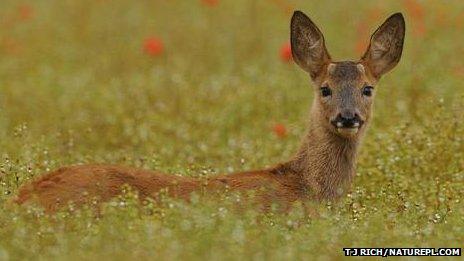Roe deer numbers 'changing woodland ecosystems'
- Published

The range and abundance of roe deer is expected to continue increasing
The increasing abundance of roe deer appears to be having an impact on woodlands, a study has suggested.
Researchers found that sites with the highest abundance of the native animals had the lowest shrub layer vegetation cover and a lower number of birds.
It is described as the first study of its kind in the UK to examine the possible impact of just one species of deer on the natural environment.
Details were presented at the British Ecological Society's annual meeting.
A team from Durham University and the Food and Environment Research Agency (Fera) carried out the study to investigate:
roe deer density and the structure and diversity of vegetation in British woodlands,
abundance and diversity of plants and birds in British woodlands.
"I collected data on vegetation cover, diversity and abundance at 35 woodland field sites across England during May and June 2011 and 2012," explained co-author Georgina Palmer from Durham University.
"Each of these field sites are part of the Breeding Bird Survey, external scheme, so - along with the vegetation data I collected - I also had access to long-running bird and deer abundance data."

Roe deer range extent in 1972 (left) and 2007. Black diamonds indicate location of field site visits in 2011 and 2012
Data collected from the 35 sites highlighted an apparent relationship between increasing roe deer density and a decrease in shrub diversity and cover.
However, Ms Palmer told BBC News: "I am still analysing this data, so cannot yet say whether roe deer are causing the reduction in shrub layer cover and, consequently, bird abundance or whether roe deer are more strongly associated with woodlands with open shrub layers."
She added that the research was the first of its kind to just look at a single species of deer.
"Much of the recent literature on impacts of deer on their environment has focused on multi-species systems and, there, authors cannot attribute impacts they find on vegetation to one particular species," Ms Palmer observed.
"My study is the first in Britain which both looks solely at the roe deer, and within natural environments, ie without the use of deer exclosures where deer densities are artificially managed."
Losing control
Six species of deer are found in the UK, of which only two are classified as native: roe and red deer, although fallow deer are considered to be part of the natural heritage as they have been present in the UK since the 11th Century. The others - muntjac, sika and Chinese water deer - were introduced in the past 150 years.
Ms Palmer's research builds on findings of a recent study that showed landowner partnerships over large areas were the best way to deter deer damage.
The findings, based on data from 80 Sites of Special Scientific Interest (SSSIs), also warned that the impact of overgrazing by deer had a knock-on effect that undermined woodland ecologies.
Since 1995, the Deer Initiative - a partnership between statutory, voluntary and private organisations - has been looking at ways to establish and promote the "sustainable management of wild deer" in England and Wales.
In order to deliver an effective management policy, the partnership highlighted a number of challenges that needed to be addressed, including:
Deer often have specific impacts on vulnerable habitat as well as agriculture and forestry
The animals tend to range over large areas (beyond site boundaries) and need to be managed on a landscape scale, with collaboration between landowners
Ecologists warn that the threat from deer to woodlands consist of a number of factors, including a reduction in the growth and density of saplings, bark damage and a change in the composition of under-storey vegetation.
The team presenting details of their study at the recent BES annual meeting in Birmingham said there was growing concern regarding the potential cascading effects deer may have on other components of biodiversity, such as fewer suitable nesting sites for birds and a reduction in food sources for other woodland species.
- Published15 September 2011
- Published17 February 2011